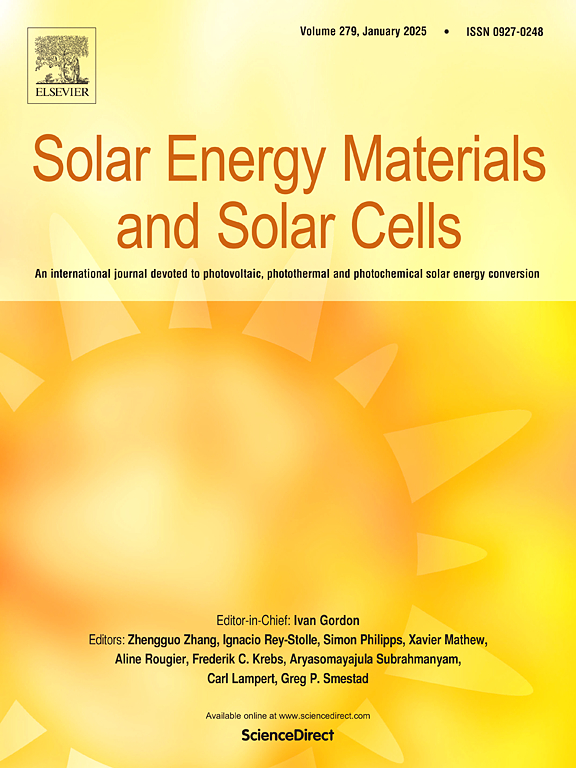Optimization of NiOₓ thin film properties and its impact on the performance of bifacial Sb₂Se₃ solar cells
IF 6.3
2区 材料科学
Q2 ENERGY & FUELS
引用次数: 0
Abstract
NiOₓ thin films show promise in Sb₂Se₃ thin film solar cells, though the optimal oxygen stoichiometry (x) remains undetermined. While most solar cells use single-sided illumination. This study demonstrates a high-performance bifacial Sb₂Se₃ solar cell with a superstrate configuration (FTO/NiOₓ/Sb₂Se₃/CdS/i-ZnO/ITO/Al), utilizing NiOₓ hole transport layer (HTL) deposited via reactive sputtering. The device's performance under single and bifacial illumination conditions was systematically investigated, along with oxygen/argon flow ratio (OAFR) optimization. At OAFR = 10 %, NiOₓ exhibited optimal stoichiometry (x = 1.04), complete columnar crystallization, and balanced Ni³⁺/Ni2⁺ ratio, resulting in high visible transmittance (81 %) and a bandgap of 3.78 eV. Under FTO-side single illumination, the device achieved an open-circuit voltage (Voc) of 0.36 V, short-circuit current density (Jsc) of 23.16 mA/cm2, fill factor (FF) of 54.46 %, and power conversion efficiency (PCE) of 4.86 %. The bifacial configuration demonstrated enhanced performance primarily through additional light harvesting from both front and rear illumination. The optimized NiOₓ HTL further supported this enhancement through efficient hole extraction and reduced interface recombination. These synergistic effects improved device performance with Jsc increasing to 29.93 mA/cm2, Voc reaching 0.414 V, and achieving a PCE of 6.72 %. The device achieves a bifaciality factor of 0.90, showing balanced performance. With an albedo factor of 0.2, the bifacial efficiency gain reaches 18 %.

求助全文
约1分钟内获得全文
求助全文
来源期刊

Solar Energy Materials and Solar Cells
工程技术-材料科学:综合
CiteScore
12.60
自引率
11.60%
发文量
513
审稿时长
47 days
期刊介绍:
Solar Energy Materials & Solar Cells is intended as a vehicle for the dissemination of research results on materials science and technology related to photovoltaic, photothermal and photoelectrochemical solar energy conversion. Materials science is taken in the broadest possible sense and encompasses physics, chemistry, optics, materials fabrication and analysis for all types of materials.
 求助内容:
求助内容: 应助结果提醒方式:
应助结果提醒方式:


